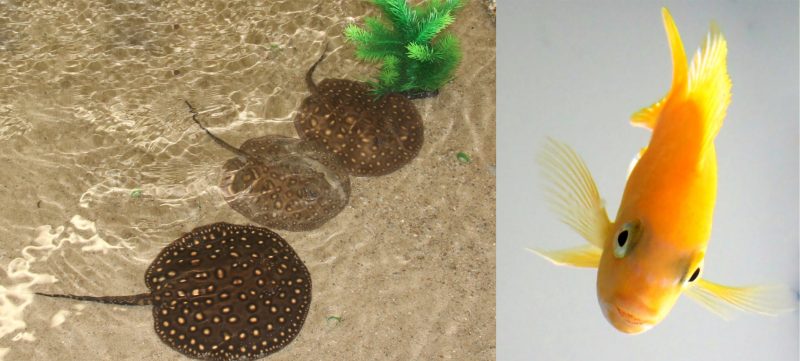
Researchers at the University of Bonn announced on April 1, 2022, that they’ve taught fish to do math. Their study involved cichlids (a popular, colorful aquarium fish) and stingrays (mostly found in oceans). The new research showed that both fish species were able to perform simple addition and subtraction of the number 1, in the number range up to 5.
The researchers published their findings on March 31, 2022, in the peer-reviewed journal Scientific Reports.
Math training for fish
Zoologist Vera Schluessel of the University of Bonn led the research team. These scientists said they knew from previous studies that cichlids and stingrays can distinguish between quantities of 3 and 4 with only a glance. It’s much the way you would know, with a glance and without having to count, whether there are 3 or 4 jellybeans in front of you.
Schluesssel decided to take it a step further to see if the fish could do simple math. She said:
We trained the animals to perform simple additions and subtractions. In doing so, they had to increase or decrease an initial value by 1.
The scientists used a test that had already been successful at teaching math to bees. They used the color blue to mean add the number 1 and the color yellow to mean subtract the number 1.

Yellow and blue shapes
The researchers showed the fish a collection of shapes, such as 4 squares. If the squares were blue, that was a signal to add 1. Next, the researchers showed the fish 2 new pictures: the first had 3 blue squares and the second had with 5 blue squares. If the fish swan to the right answer (the 5 blue squares), they received a reward of food. Wrong answers meant no food. Over time, they learned that the blue color meant increase one and the yellow color meant decrease one.
The researchers wanted to make sure the fish were learning the concepts behind the math and not memorizing rules. Schluessel said:
To check this, we deliberately omitted some calculations during training. Namely, 3+1 and 3-1. After the learning phase, the animals got to see these two tasks for the first time. But even in those tests, they significantly often chose the correct answer.
When the fish were shown 3 blue shapes and then presented with pictures of both 4 blue shapes and 5 blue shapes, the fish chose the 4 blue shapes. This indicated that the fish learned the rule is not just choose the largest, but the more specific add one.
But the task was even more difficult than described above. The researchers didn’t just show the fish all the same objects, but a combination of shapes. The number 3 could be represented by 2 different-sized circles and a square. Or the number 4 might be a big and little triangle plus a circle and square.

Differences in cichlids and stingrays
Are stingrays better at math than cichlids? Maybe. The study said:
Cichlids needed more sessions than stingrays to reach the learning criterion … Individual performance of stingrays exceeded that of cichlids.
The study also said:
Addition was learned more easily than subtraction by both species.

Fish can do math
The researchers were surprised. These 2 types of fish aren’t known for being good at math in the wild. For example, other fish are known to count the amount of eggs they lay. But stingrays and cichlids haven’t demonstrated this behavior. The researchers also pointed out that these fish could do math while lacking a cerebral cortex. That’s the part of the brain that performs more complex tasks.
Schluessel remarked on the higher level of thinking that the math tasks required:
The animals had to recognize the number of objects depicted and at the same time infer the calculation rule from their color. They had to keep both in working memory when the original picture was exchanged for the 2 result pictures. And they had to decide on the correct result afterwards. Overall, it’s a feat that requires complex thinking skills.
The scientists pointed out that, in contrast to mammals, fish are often underestimated. One common misconception is that goldfish have a 3-second memory. On the contrary, these scientist said, research has shown that goldfish can remember things for months.
But it is true that fish aren’t furry or cuddly. They don’t bark or roar or seem to interact much with humans. Because of these factors, Schluessel said:
They are quite far down in our favor, and of little concern when dying in the brutal practices of the commercial fishing industry.
Bottom line: Researchers have shown that fish can do math. They taught them to add or subtract one unit for groups of colored shapes up to five.
Source: Cichlids and stingrays can add and subtract ‘one’ in the number space from one to five











